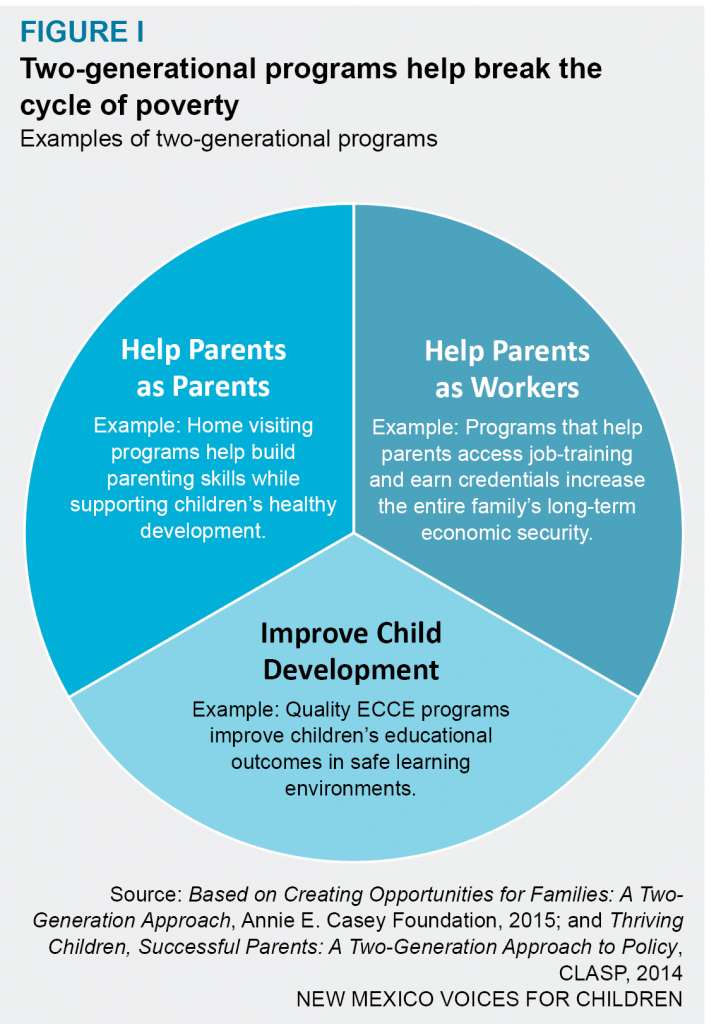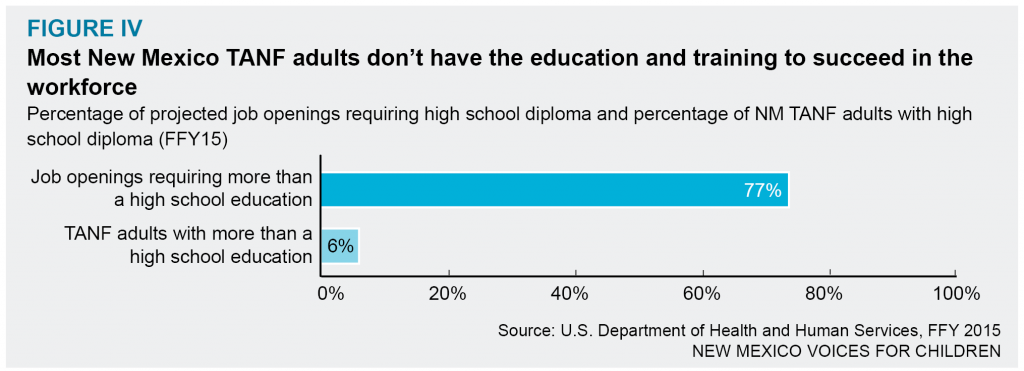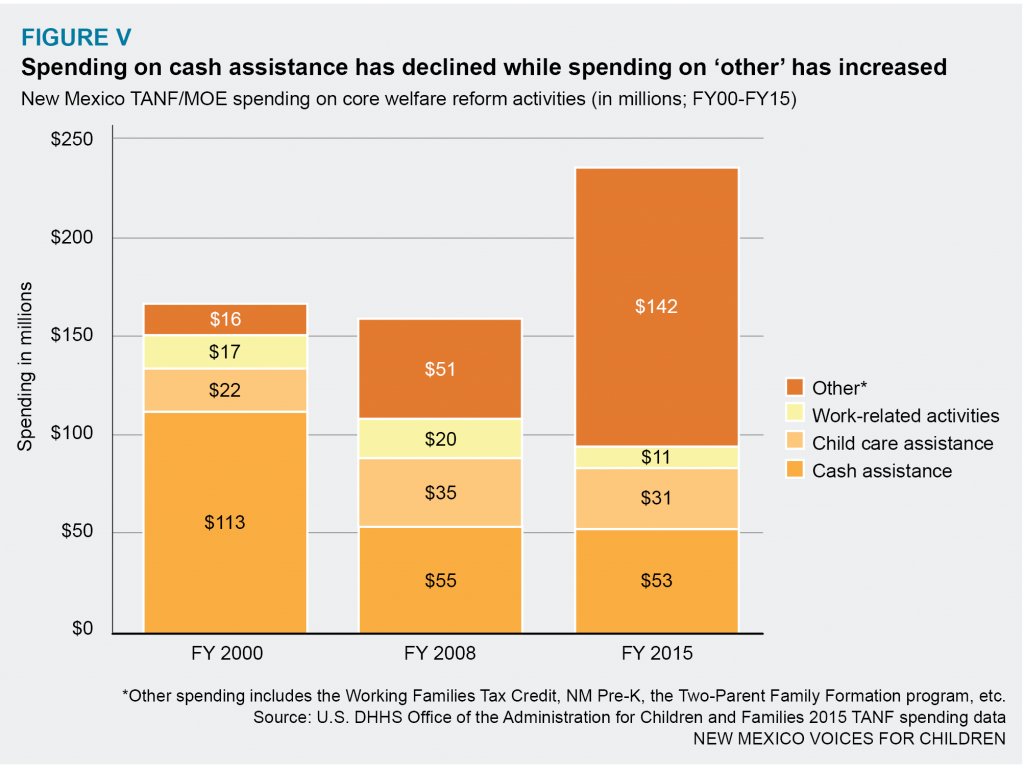 Improving TANF and Implementing Two-Generational Solutions to Help New Mexico Families Access Educational Pathways Out of Poverty
Improving TANF and Implementing Two-Generational Solutions to Help New Mexico Families Access Educational Pathways Out of Poverty
A KIDS COUNT Special Report
Executive Summary
Download this executive summary (Dec. 2016; 4 pages; pdf)
Download the full report by Armelle Casau, Ph.D., and Virva Walkington, MPH (Dec. 2016; 16 pages; pdf)
Our communities are stronger when we ensure that all parents and children have access to the resources and opportunities they need to succeed and thrive. The Temporary Assistance for Needy Families (TANF) program, formerly known as welfare, provides some cash assistance to eligible families with children so they can better afford basic necessities. When welfare was reformed twenty years ago, the cash assistance—with some exceptions—became tied to work or work-related activity requirements. Unfortunately, TANF does not sufficiently address one of the reasons families fall into or remain in poverty: the lack of education credentials and job skills, which present barriers to employment and to getting jobs that pay family-sustaining wages.
Additionally, while families receiving TANF cash assistance are generally eligible for child care assistance, too little focus is spent on making sure children in TANF families have the opportunity to participate in quality early childhood care and education programs (ECCE), including child care, that increase their school readiness and provide safe learning environments while their parents are at work or furthering their education or training.
 A two-generational approach is needed
A two-generational approach is needed
Since TANF only serves families with children, the program should use a two-generational approach to help families gain long-term economic self-sufficiency (see Figure I). Because of the strong correlation between poverty and low levels of educational attainment, education is key. When parents increase their education and work skills, subsequent higher incomes improve their family’s living standards as well as their children’s future economic security as adults. When young children participate in quality ECCE programs, their educational outcomes also improve, which helps break the generational cycle of poverty.
TANF in New Mexico helps too few families with too little assistance
Considering that the state has the second worst child poverty rate in the nation (28.6 percent) and ranks 49th in overall child well-being according to the Annie E. Casey Foundation’s 2016 KIDS COUNT rankings, the TANF program in New Mexico should better serve our many vulnerable children and their families. Across the state, only 23,432 children—or 17 out of every 100 children living in poverty—were served by TANF in 2015 (see Figure II). The cash assistance is also time limited to 60 months over a lifetime and is too little for a family to live on while parents look for work or attend school. A family of three receives an average of $409 per month. This represents a 30 percent drop from 20 years ago when adjusted for inflation.

Children on TANF need increased access to quality ECCE programs
Since cognitive delays start early in children living in poverty, and children who start behind in school often fall further behind, quality ECCE programs are needed to provide nurturing, stable, and safe environments while promoting school readiness and early reading skills that can set children on a path to success in both school and in life. While the state has increased funding for some ECCE programs, including the NM Pre-K program and home visiting, funding for other programs, like child care assistance, has stagnated. Future ECCE funding is at risk due to current budget pressures, even though the need for all of these programs is not close to being met.
ECCE programs are also not targeted explicitly enough to TANF families. Almost $31 million of federal TANF funds in FY17 are being used for child care assistance but just 4 percent of New Mexico’s TANF families received child care assistance even though 40 percent of children on TANF are 5 years old or younger (see Figure III). Data are also not collected for how many of the 23,432 children on TANF are benefiting from other ECCE programs like home visiting and NM Pre-K even though nearly $23 million of federal TANF funds are being spent on those two programs.

TANF adults need access to effective education and training programs
In today’s economy, most family-sustaining jobs require some level of post-secondary education. In New Mexico, 77 percent of projected job openings will require some college education and yet, only 6 percent of the 7,688 TANF adults in the state have more than a high school education (see Figure IV). Parents living in poverty need access to education and training programs as many struggle with academic deficiencies in basic math, reading, and writing or lack college or workforce credentials, all of which makes them non-competitive for most family-sustaining jobs.
Considering that the TANF program was built around participation in work or work-related activities, New Mexico ought to spend significant amounts of their TANF funding on effective education and training programs. Unfortunately, the state in FY15 spent only 5 percent of its combined federal TANF funds and state maintenance of effort (MOE) funds (referred to as TANF/MOE) on work-related activities for TANF adults (including skills assessment, employment search, and subsidized job training) and zero TANF/MOE funds on education and training programs even though this is an allowable and recommended category under work-related activities.
Across the nation, workforce development experts are advocating for states to prioritize career pathways programs that move non-traditional, low-skilled adults along an education and training continuum into post-secondary education that leads to credentialing in high-growth industries. New Mexico should follow the lead of other states that are leveraging TANF funds and the Workforce Innovation and Opportunity Act (WIOA) to develop and sustain a statewide career pathways frameworks.
New Mexico’s TANF program should implement two-generational strategies
We need to ensure that services for both children and parents are linked, aligned, and coordinated in a two-generational approach so these services can do a better job of improving outcomes for the whole family than can services provided in isolation. Strategies the state should adopt include co-designing and co-locating services (e.g. a center-based program where infants are cared for in the same location as parents are developing parenting and work-related skills); targeting programs to TANF families (e.g. setting aside funding for a home visiting program just for TANF families); coordinating between agencies (e.g. hiring a two-generation manager to identify and recommend poverty reductions strategies across agencies); and providing education and training programs with comprehensive supports for parents (e.g. using TANF and WIOA funds to support a career pathways framework that provides tuition, case managers, career coaches, transportation assistance, and child care assistance).

We should also do away with New Mexico TANF policies that hurt parents and their children. This includes full-family sanctions, full-family time limits, and the lack of an automatic work exemption for single-parent heads of families with infants. In addition, New Mexico needs to better prioritize its TANF funding to serve the population it’s intended to serve—our many families with children struggling with poverty. New Mexico spends only 40 percent of its TANF/MOE funds on the core TANF activities—basic cash assistance, work and work-related activities, and child care assistance (see Figure V).
Policy Recommendations
Implement two-generational TANF strategies so parents and children benefit at the same time
• Co-design programs and co-locate services for TANF parents and children.
• Target programs specifically to TANF families and coordinate between agencies to increase prioritization of TANF families.
• Support career pathways programs that provide comprehensive supports for TANF parents.
• Increase the minimum wage and provide more opportunities for subsidized job training for TANF parents.
Change New Mexico TANF rules that hurt children in addition to adults
• Automatically exempt single-parent heads of families, pregnant women, and mothers of infants from TANF work requirements.
• Remove full-family TANF sanctions and full-family TANF time limits.
Better target TANF funding so struggling families can escape the generational cycle of poverty
• Spend more TANF/MOE funds on education and training activities.
• Increase TANF cash assistance levels and include cost-of-living adjustments.
• Use a small percentage of the $15 billion Land Grant Permanent Fund for ECCE programs.
• Generate additional state revenues while addressing regressive tax code provisions to support two-generational TANF strategies.
Find more data for New Mexico and the nation on the KIDS COUNT Data Center
NM KIDS COUNT is a program of the Annie E. Casey Foundation.
